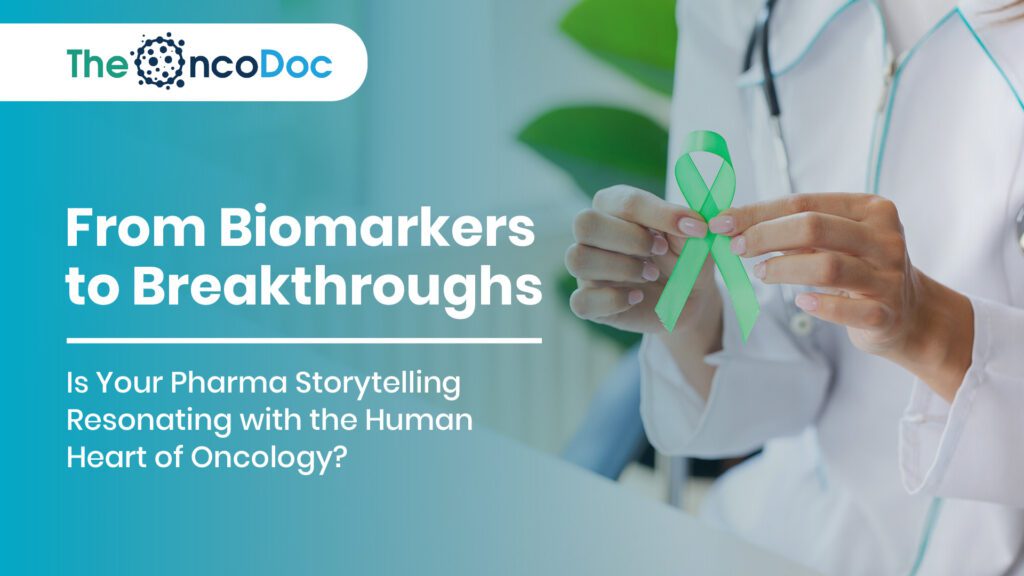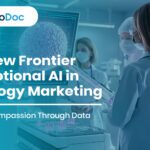Abstract
In the complex and data-rich world of oncology, scientific communication is often characterized by intricate clinical jargon, complex statistical analyses, and a focus on molecular mechanisms. While essential for scientific rigor, this dense information can inadvertently create a barrier to genuine engagement, not just for patients, but surprisingly, for many healthcare professionals (HCPs) and their families. The human brain is wired for stories, and even the most scientifically astute oncologist responds to narratives that connect data to real-world impact. This article explores “Turning Clinical Jargon into Human Stories: Pharma’s Secret to Engagement,” arguing that effective storytelling is the untapped power for pharmaceutical companies to drive deeper understanding, foster empathy, and enhance the adoption of innovative cancer therapies.
We will analyze why narrative communication is crucial in the US oncology market, where information overload and time scarcity plague both HCPs and patients. The article will delve into the art and science of transforming complex clinical data (e.g., progression-free survival, overall response rate, specific adverse event profiles) into relatable patient journeys, compelling physician insights, and impactful disease awareness campaigns. Crucially, this article will demonstrate how Artificial Intelligence (AI) is revolutionizing this storytelling imperative. We will examine how AI, through advanced natural language processing (NLP), generative AI, and sentiment analysis, enables pharma marketers to: 1) Extract Human Narratives from Clinical Data; 2) Personalize Storytelling for Diverse Audiences; 3) Scale Compliant Content Creation; 4) Optimize Emotional Resonance; and 5) Measure Narrative Impact.
The discussion will be grounded in the specifics of the US oncology field, providing actionable strategies for pharma managers to leverage AI, not just for content automation, but for the empathetic and powerful translation of scientific breakthroughs into human stories that resonate, educate, and ultimately improve cancer care journeys.
Introduction: The Language of Science vs. The Language of Life
Oncology is a field of immense scientific achievement. Researchers toil for decades, clinical trials enroll thousands, and regulatory bodies meticulously scrutinize mountains of data, all culminating in therapies that can extend lives, alleviate suffering, and even cure once-fatal diseases. The language used to describe these triumphs is, by necessity, precise, technical, and data-driven: hazard ratios, p-values, progression-free survival curves, and molecular targets. This is the language of science, the bedrock of evidence-based medicine.
However, the impact of these breakthroughs is measured in human terms: a parent getting more time with their children, a patient regaining their independence, a physician seeing the hope rekindled in their patient’s eyes. The disconnect between the language of science and the language of human experience is a persistent challenge for pharmaceutical companies in the US oncology market. While oncologists are scientifically trained, they are also human beings who process information, make decisions, and feel emotions. Patients and caregivers, often grappling with complex diagnoses, desperately seek clarity and connection.
This article makes a compelling case that storytelling is not a ‘soft skill’ in pharma marketing, but a strategic imperative, a “secret to engagement” that unlocks deeper understanding and action. It is the bridge that transforms abstract clinical jargon into relatable human experiences. Furthermore, we will demonstrate that in the age of digital marketing, Artificial Intelligence is becoming the most powerful enabler of this storytelling revolution, allowing pharma to craft and deliver narratives that resonate authentically and at scale. By leveraging AI, pharma marketers can elevate their role from mere disseminators of data to architects of empathy and understanding, ultimately strengthening the entire cancer care ecosystem.
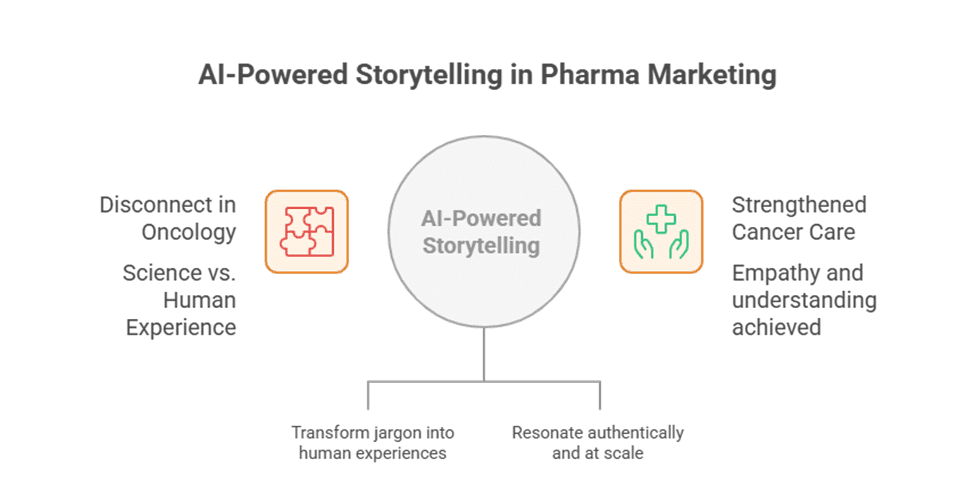
Why Storytelling Matters in Oncology: The Human Element of Science
The human brain is hardwired for stories. From ancient myths to modern advertisements, narratives captivate our attention, evoke empathy, and make information more memorable and actionable. In oncology, this power is amplified.
1. Combating Information Overload
- The Challenge: Oncologists are inundated with scientific data. PDFs of clinical trials, journal articles, conference presentations – the volume is overwhelming. Pure data, without context, is easily forgotten.
- The Solution: A compelling patient story or a concise narrative from an expert can serve as an anchor, making complex data points more memorable and relevant. For example, rather than just stating “median PFS of 12 months,” a story about “Sarah, who gained an extra year with her family thanks to this therapy,” makes the statistic resonate.
2. Fostering Empathy and Understanding
- The Challenge: For physicians, understanding a drug’s mechanism of action is one thing; truly appreciating its impact on a patient’s daily life is another. For patients, navigating a complex diagnosis can feel isolating.
- The Solution: Stories build bridges. A physician’s narrative about a challenging case successfully managed, or a patient’s journey through treatment and recovery, fosters empathy and a deeper understanding of the human dimension of care. This is crucial for both HCP education and patient support.
3. Driving Engagement and Recall
- The Challenge: Generic marketing messages often fail to capture attention. In a competitive market like US oncology, standing out requires more than just listing benefits.
- The Solution: Stories are inherently engaging. They create an emotional connection that pure data often cannot. People remember stories long after they’ve forgotten statistics. This drives higher engagement with educational materials and greater recall of key messages.
4. Facilitating Complex Decision-Making
- The Challenge: Treatment decisions in oncology are rarely black and white. They involve balancing efficacy, safety, patient preferences, and quality of life.
- The Solution: Case studies (which are essentially structured stories) allow oncologists to see how a therapy performs in a real-world context, addressing the nuances of patient management. Patient narratives can help patients and their families understand what to expect.
5. Building Trust and Authenticity
- The Challenge: Pharma often faces skepticism regarding its commercial motives.
- The Solution: Authentic, transparent stories – whether from patients, physicians, or researchers – can humanize the brand, building trust and demonstrating a genuine commitment to improving patient lives beyond just selling a product.
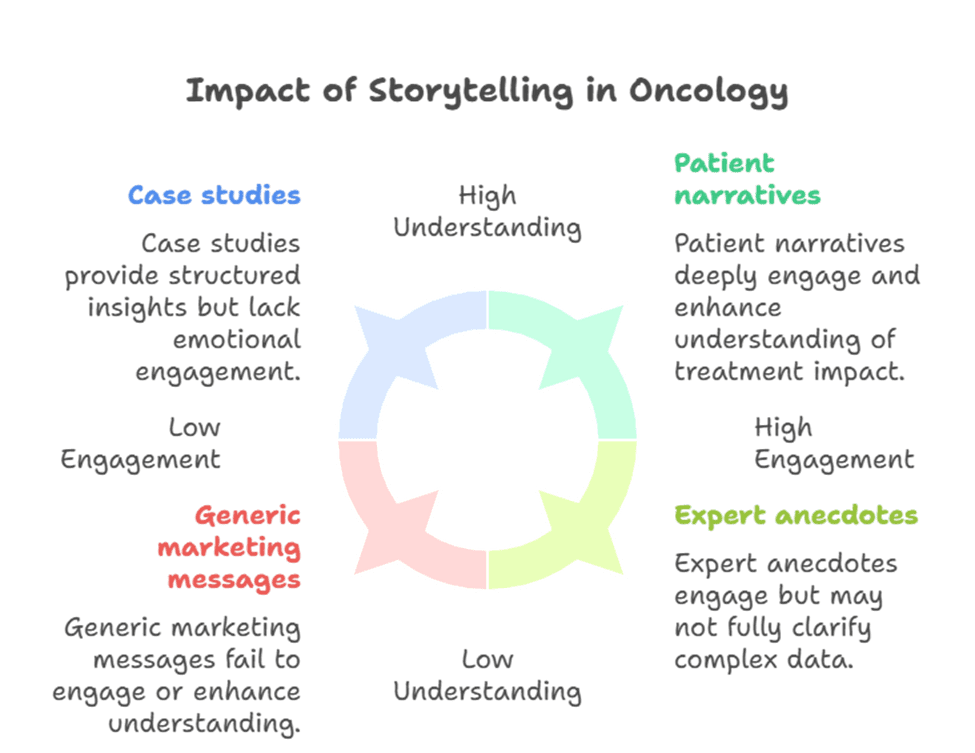
AI as the Storyteller’s Ally: Transforming Jargon into Narrative
While the human element remains central to authentic storytelling, Artificial Intelligence is rapidly becoming an indispensable tool for pharma marketers to overcome the inherent challenges of creating, personalizing, and scaling compelling narratives.
1. Extracting Human Narratives from Clinical Data (NLP & ML)
- The Problem: Raw clinical trial data, medical records, and scientific publications are a treasure trove of human experience, but extracting the “story” is incredibly difficult.
- The AI Solution: Advanced Natural Language Processing (NLP) and Machine Learning (ML) can analyze vast, unstructured datasets (e.g., patient-reported outcome (PRO) data, verbatim feedback from surveys, adverse event reports, clinical notes – all anonymized) to identify common themes, patient experiences, and qualitative insights related to a specific therapy or disease.
- Practical Application: AI can identify recurring phrases in patient feedback like “I finally got my energy back” or “the side effects were manageable, unlike previous treatments.” These insights become the building blocks for authentic patient stories, highlighting aspects of treatment that resonate most with patients and families. Similarly, AI can analyze HCP feedback to identify common “pain points” or successes that can be woven into physician-focused narratives.
2. Personalizing Storytelling for Diverse Audiences (Generative AI & ML)
- The Problem: A single patient story or case study won’t resonate with every oncologist or every patient. Different sub-specialties, demographics, and cultural backgrounds require tailored narratives.
- The AI Solution: Generative AI, fueled by ML-driven audience segmentation, can dynamically adapt existing stories or create new narrative variations to suit specific target audiences. It can adjust language, emphasis, and cultural references to maximize resonance.
- Practical Application: For an oncologist specializing in prostate cancer, AI can generate a case study focusing on a prostate cancer patient’s journey with a new drug, highlighting specific urological side effect management. For a patient in a Spanish-speaking community, the AI can re-write a key message about adherence in their native language, incorporating cultural nuances, while ensuring scientific accuracy (with human review).
3. Scaling Compliant Content Creation (Generative AI & MLR Automation)
- The Problem: Crafting multiple, high-quality, compliant stories is incredibly time-consuming and expensive, especially given the stringent medical, legal, and regulatory (MLR) review process in the US.
- The AI Solution: Generative AI can rapidly draft initial versions of patient stories, physician testimonials (based on approved quotes), or case study outlines. AI-accelerated MLR tools can then pre-screen these drafts for compliance, flagging potential issues and referencing approved claims or boilerplate language.
- Practical Application: A pharma company needs 20 variations of a patient adherence story for different oncology indications and patient profiles. Generative AI can create initial drafts that are then refined by human storytellers and swiftly moved through an AI-assisted MLR workflow, drastically cutting down production time and cost.
4. Optimizing Emotional Resonance and Impact (Sentiment Analysis & Predictive Analytics)
- The Problem: It’s challenging to objectively measure the emotional impact or resonance of a story before deployment. What evokes hope in one audience might cause anxiety in another.
- The AI Solution: AI-powered sentiment analysis can pre-test different narrative approaches with target audience proxies to predict emotional responses. Predictive analytics can then optimize story elements (e.g., tone, imagery, specific narrative arcs) for maximum engagement and desired emotional impact.
- Practical Application: Before launching a campaign, AI can analyze different versions of a patient testimonial video to predict which one elicits the most positive sentiment and highest engagement among a test group of oncologists. This allows for data-backed optimization of storytelling elements.
5. Measuring Narrative Impact and Refining Strategy (Analytics & ML)
- The Problem: Measuring the true impact of storytelling beyond vanity metrics (views, likes) is difficult. How does a story translate to increased understanding, changed behavior, or improved outcomes?
- The AI Solution: AI integrates engagement data (time spent on story content, sharing rates, comments, subsequent actions like downloading a clinical paper or requesting a rep visit) with outcomes data (e.g., treatment adherence rates, physician prescribing patterns where permissible and anonymized). ML models then correlate narrative elements with tangible impacts, providing iterative feedback for future storytelling.
- Practical Application: AI might reveal that patient stories focusing on “return to hobbies” significantly increase engagement among younger oncologists, leading to a strategic adjustment in storytelling themes for that segment. It can also help measure if specific patient narratives correlate with better patient adherence, indicating the direct impact of empathetic communication.
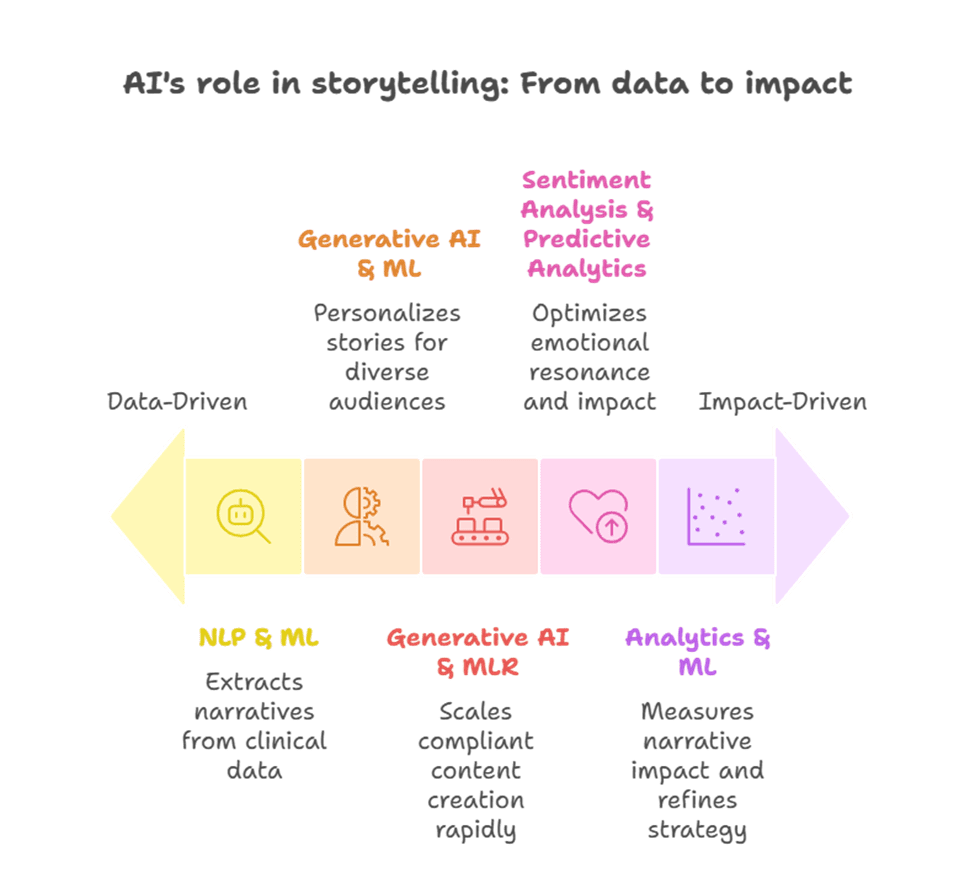
The US Oncology Market: A Compelling Case for Human-Centric Stories
The US oncology market, characterized by cutting-edge innovation and intense competition, provides a strong rationale for AI-powered storytelling:
- High Emotional Stakes: Cancer is profoundly personal. Stories resonate more deeply here than perhaps anywhere else in medicine.
- Complex Therapies: New targeted and immunotherapies are incredibly complex. Stories can demystify mechanisms of action by showing their real-world impact.
- Demographic Diversity: The US population is highly diverse, requiring culturally competent and relatable narratives that speak to varied experiences. AI facilitates this at scale.
- Evolving HCP Landscape: Younger oncologists are digital natives who appreciate engaging, multi-modal content formats beyond traditional lectures.
- Patient Empowerment: Patients are increasingly active participants in their care. Pharma has a responsibility to provide understandable, empowering narratives.
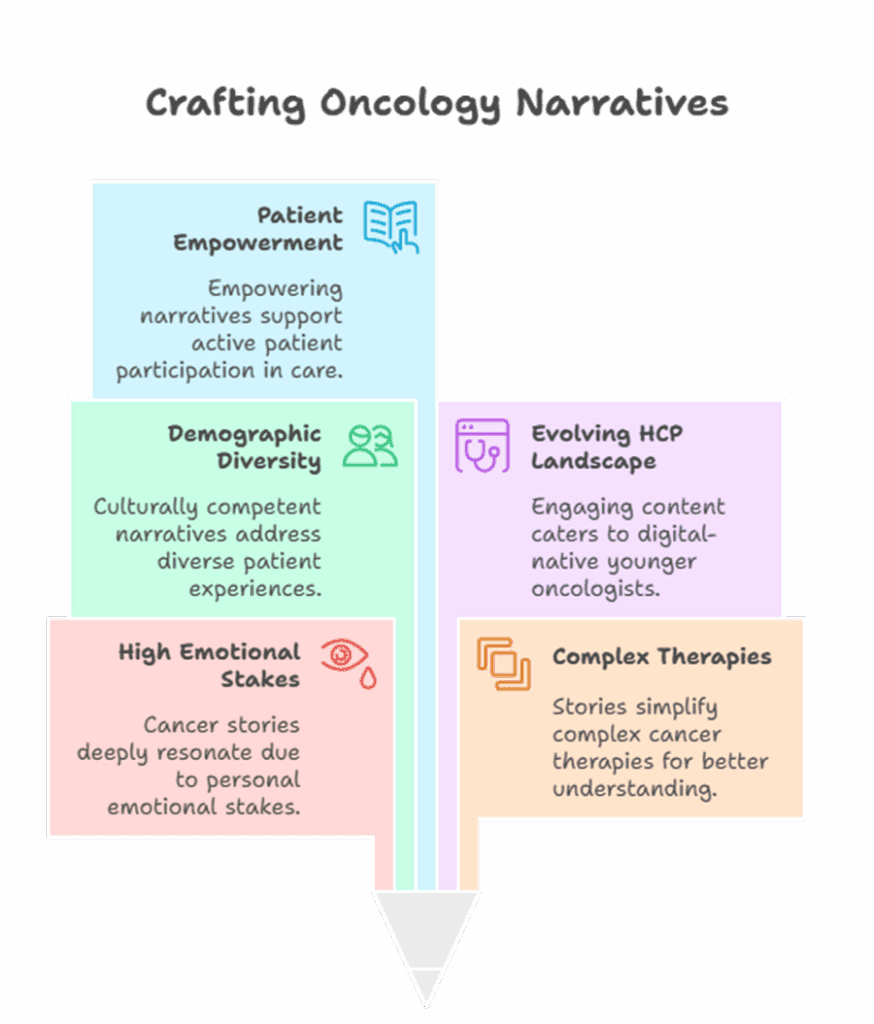
Challenges and Ethical Imperatives
While AI offers immense power for storytelling, ethical considerations are paramount:
- Authenticity and Truth: AI-generated stories must always be grounded in real data and adhere to the highest standards of scientific accuracy and ethical representation. They should never be fabricated or misleading. Human oversight is non-negotiable.
- Patient Privacy and Consent: When drawing insights from patient data, strict adherence to HIPAA and other privacy regulations is essential. All patient stories, even AI-assisted, must be based on explicit consent for data use.
- Avoiding Manipulation: The power of emotional resonance must be wielded responsibly. AI should enhance understanding and empathy, not manipulate decisions.
- Maintaining the Human Touch: AI is a tool to empower human storytellers, not replace them. The creativity, empathy, and nuanced understanding of human experience remain a human domain.
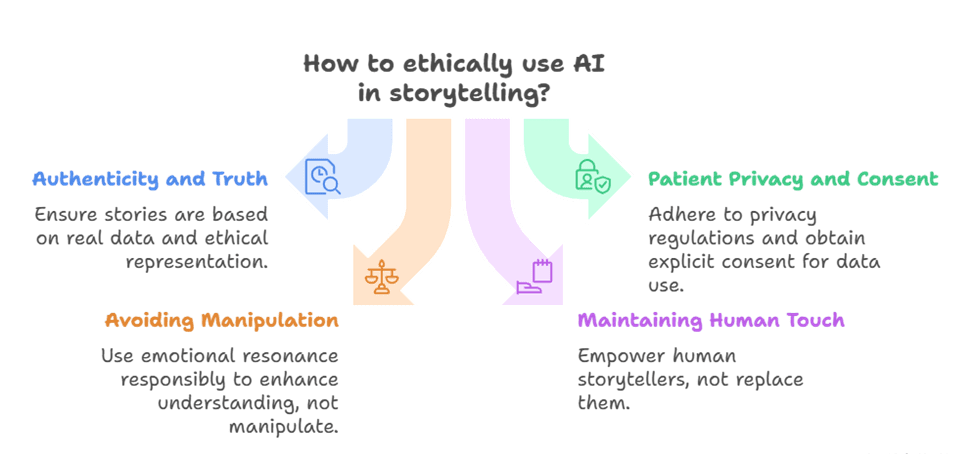
Conclusion: Weaving Science with Soul in the Digital Age
In the relentless pursuit of scientific advancement, pharmaceutical companies in the US oncology market must remember the fundamental truth: at the heart of every data point, every clinical trial, and every breakthrough therapy, there is a human story. Transforming clinical jargon into these powerful narratives is no longer a luxury but a strategic imperative for genuine engagement.
Artificial Intelligence is the modern-day loom that allows pharma marketers to weave together the threads of complex scientific data with the rich tapestry of human experience. By leveraging AI to extract, personalize, scale, optimize, and measure the impact of stories, pharma managers can move beyond transactional communication to truly resonate with the hearts and minds of oncologists, patients, and caregivers. This human-centric approach to digital marketing not only fosters deeper understanding and builds trust but also accelerates the adoption of life-changing therapies, ultimately fulfilling pharma’s mission to improve lives. The future of oncology marketing is not just smart; it is soulful, powered by AI, and driven by compelling human stories.
The Oncodoc team is a group of passionate healthcare and marketing professionals dedicated to delivering accurate, engaging, and impactful content. With expertise across medical research, digital strategy, and clinical communication, the team focuses on empowering healthcare professionals and patients alike. Through evidence-based insights and innovative storytelling, Hidoc aims to bridge the gap between medicine and digital engagement, promoting wellness and informed decision-making.

